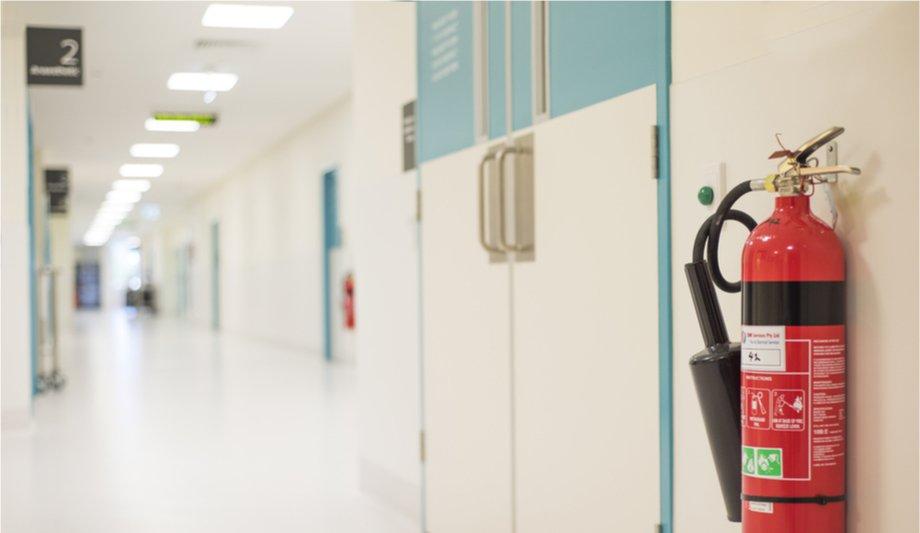According to the 2009 edition of the Emergency Care Research Institute Health Devices Guide, operating room fires rank third on the top 10 technology hazards. ECRI estimates that between 550 to 650 fires occur in operating rooms in the United States. The most common sites where fires were the head, face, neck and upper chest (Hart, MD et al. 2011) which means that patients are disproportionately at risk compared to patients exposed to fire risks in other parts of a hospital.
Fire hazards in Operating Rooms
I’ve had the opportunity to participate in the design or implementation of fire protection and life safety systems at different stages in several hospitals across Latin America. In these projects, fire professionals have recognized the importance of protecting the operating room from fire and electrical risks. The risk is heightened considering the cost of the medical equipment that exists there, but not many people really grasp the level of risk that exists during surgery.
The risk is heightened considering the cost of the medical equipment
Fires in these type of places are especially deadly because they might occur directly on the skin or air ways of patients on oxygen enriched environments. Hospital designers and planners should focus on prevention first, and with the help of medical experts create an environment where the likelihood of a fire is kept to the minimum, and where doctors and nurses have access and means to put down fires and keep patients out of harm.
Common fire sources
The most common fire sources that can be found in this type of environment are medical PPEs, such as gowns, hood and masks, drapes, towels and sponges that cover or are used over the patient’s skin, as well as plastic tubes and accessories directly attached to the patient and that might go into the airways. There are also different kinds of flammable chemicals and alcohol-based solutions used to prepare and clean the patient and the presence of medical gases. ECRI considers the patient’s skin and hair can be considered as fire sources as well, when certain conditions are met, like high oxygen concentrations on the air.
According to the ECRI guide, 68% of fires in operating rooms were caused by electrosurgery equipment and other electrical hemostatic devices. In these environments prone to high concentrations of oxygen, any spark can become a potential ignition source. Between the medical equipment that might cause sparks, you can find: high speed surgical drills, defibrillators, lasers and electrocautery units. Of course, the most obvious ignition sources found in an OR are damaged cables and wires.
The NFPA 99 (Standard for Fire Protection in Healthcare Facilities) considers that medical air and gas distribution systems have an inherent risk of fire and explosion associated with them, because these gases can act as oxidizers and create ideal conditions for ignition. Many studies indicate that almost any material can ignite with oxygen concentrations on the air above 30% (normal O2 concentration on the air is 21%). It’s also important to mention that nitrous oxide used in anesthesia supports combustion the same manner as oxygen (Hart MD. Et al. 2011).
Types of Fires and how to minimize their risk
According to the ECRI, fires in the operating room environment can be divided into fires that occur in the OR environment, like ignitions on medical equipment or materials stored or located around the operating table, and fires that ignite directly over the skin and airways of the patient. Many studies consider that 44% of fires over the patient’s skin are in the face, neck, head or upper chest and 21% on the airways.
“The basic elements of a fire are always present during surgery” says Mark Bruley, vice president of Accident and Forensic Investigation on ECRI. “Slow reaction or the use of improper firefighting techniques and tools can lead to damage, destruction or death”. This calls for active involvement of the medical staff, including surgeons and anesthesiologists, in fire prevention training and pre-surgery planning.
 |
| The basic elements of fire, such as oxygen, are always present during surgery |
Fire prevention in pre-surgery planning
ECRI and the FDA (Food and Drug Administration) strongly recommend that surgeons and nurses should include fire prevention and possible hazard identification during their pre-surgery planning. “Each one control a specific side of the fire tetrahedron and by properly managing their technique and part of the equation, surgical fires can be avoided” says Bruley.
Medical staff should identify the location of gas and oxygen shutoff valves and evaluate the need of oxygen concentrations above 25%. Organizations like the OMS recommend avoiding the use of open oxygen sources on the face during procedures and use tracheal tubes or laryngeal masks instead. Also, it’s a good practice to use floor to ceiling drapes to create a barrier between the oxygen-enriched atmosphere around the operating table and the rest of the room.
Staff should participate in drills and training on the use of firefighting equipment
Also, ECRI recommends that all the staff should participate in drills and training on the use of firefighting equipment and rescue and escape methods. In case of a fire, all oxygen and medical gas sources need to be managed, and medical equipment removed or relocated (if possible) if they are directly affected by fire or the fire extinguished in place.
It’s important to note that ECRI and other institutions, like the World Health Organization, recommend that fire extinguishers should be used only after the patient has been safely removed from the hazard. In extreme cases of fires over the patient’s skin, ECRI says that a CO2 extinguisher is preferable because they minimize tissue contamination and damage.
Fire Protection Equipment in the Operating Room
The IFC (International Fire Code) and the NFPA 99 and 101 (Life Safety Code) provide several guidelines to manage fire safety in healthcare facilities.
Fire protection means can be passive or active, and one of them doesn’t exclude the other. Passive fire protection serves the purpose to minimize fire spread through ventilation, electrical wiring and openings through walls and windows. They need to be designed to keep flames and smoke from nearby fires away from the operating room, and to prevent smoke and flames that might occur inside one operating room to spread to the nearby areas.
These protections include, but are not limited to:
- Walls, floors and ceilings should not only be fire rated for 120 minutes, and doors for at least ¾ of that time, but to be constructed in a manner that they are sealed to prevent smoke and flame leakage inside and outside.
- Use of fire stoppings in all ventilation, electrical and other kind of ducts that go through fire rated walls, floors or ceilings.
- Use of intumescent coverings in all structural and non-structural elements.
- Use of fire-retardant furniture, although is important that almost no material is fire retardant in atmospheres where the oxygen concentration is over 30%.
- Dampers and smoke control systems.
All electrical systems and medical air, gas and oxygen distribution systems should be designed according the guidelines of the NFPA 70 (National Electrical Code) and the NFPA 99.
Active fire protection
Active fire protection includes automatic detection and alarm and extinguishing measures
Active fire protection includes automatic detection and alarm and extinguishing measures. Fire extinguishers should be located for easy access and clearly identified by a plastic sign from the wall to the ceiling.
Even though the NFPA 101 recognizes that fire sprinklers are mandatory in healthcare facilities, they should not be activated during an active surgery because this water might contaminate open wounds. In fact, ECRI recommends against the use of any water-based fire extinguished in operating rooms, including water mist systems. Also, the ECRI mentions that water that pools near or below medical equipment can cause electric shocks to the occupants.
Regarding automatic detection and alarm, point type smoke detectors are not recommended for this type of application because they can accumulate dust, and regular dust contains levels of dead human tissue that might contaminate the environment.
early fire detection
Operating rooms call for early detection to avoid damages to costly medical equipment, but most importantly to minimize the risk and exposure to smoke and flames to staff and patients. The preferred detection method for this kind of application is aspirating smoke detection. Considering that operating rooms usually use forced ventilation, international guidelines propose the use of high sensibility detectors. The EN 54-20 prescribes Class 1 o Class 2 sensibility for rooms with high velocity air changes.
Bosch Security and Safety Systems offer the Invisible Type smoke detector which doesn’t use a smoke chamber to detect smoke particles, but instead uses a state of the art technology and patented infrared source arrangement that allows it to be completely flat and with no openings. This detector can be easily cleaned, and with the IP66 back box accessory it doesn’t accumulate any dust whatsoever. Duct smoke detection should be installed in the air conditioning ducts to activate dampers and smoke control systems.
As with fire extinguishers, manual pull stations should be properly located and identified to allow medical staff to give alert of a potential fire hazard.
Notification appliances
Notification appliances activate in specific areas of the hospital
In the event of a fire, notification appliances activate in specific areas of the hospital, related to the fire location and risk. Inside operating rooms only visible notification is recommended, because audible signals might affect patient’s wellbeing. Voice evacuation should be activated in common and prepping areas nearby the operating rooms. All the fire detection and notification devices shall be connected to a central Fire Alarm panel (FACP) to allow staff in charge of fire and evacuation response to receive timely information and make real time decisions.
The panel and all the systems related to fire detection and evacuation should be installed according to the NFPA 72 (National Fire Alarm and Signaling Code), EN 54-14, BS 5839 or any local relevant guidelines.
Proper maintenance of all passive and active fire protection systems and regular training and preparation from medical staff and doctors are critical to minimize the risk of fires in operating rooms. Prevention is the first step, but when fires occur, optimal outcomes depend on coordinated team efforts (Hart MD. Et al, 2011). Also, a comprehensive fire safety program should be implemented in all hospital areas, including operating rooms.




















